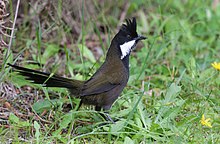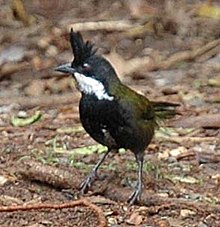Psophodidae
| Psophodidae | |
|---|---|

| |
| Eastern whipbird(Psophodes olivaceus) | |
| Scientific classification | |
| Domain: | Eukaryota |
| Kingdom: | Animalia |
| Phylum: | Chordata |
| Class: | Aves |
| Order: | Passeriformes |
| Superfamily: | Orioloidea |
| Family: | Psophodidae Bonaparte,1854 |
| Genera | |
|
Seelistbelow | |
Psophodidaeis afamilyofpasserinebirds native to Australia and nearby areas. It has a complicated taxonomic history and different authors vary in which birds they include in the family. In the strictest sense, it includes only the five or six species of whipbirds and wedgebills (PsophodesandAndrophobus), but some authors also include thequail-thrushes(Cinclosoma), eightspeciesof ground-dwelling birds found in Australia andNew Guinea,and thejewel-babblers(Ptilorrhoa), three or four species found in rainforest in New Guinea. Others place them in their own family, theCinclosomatidae.TheMalaysian rail-babbler(Eupetes macrocerus) was formerly sometimes placed in this family, which would then be called Eupetidae.
Taxonomy
[edit]The quail-thrushes, jewel-babblers, whipbirds and wedgebills were traditionally included with thelogrunners(Orthonyx) in the family Orthonychidae.[1]Sometimes the Malaysian rail-babbler andblue-capped ifrit(Ifrita kowaldi) were also included in the family.[2]In 1985,Sibley and Ahlquistfound that the logrunners were not related to the others and included only the logrunners in the Orthonychidae.[3]They treated the others as thesubfamilyCinclosomatinae within their expanded familyCorvidae.[4]
A number of authors later treated the quail-thrushes and allies as the family Cinclosomatidae, a name first coined by Gregory Mathews in 1921–1922. However, if the whipbirds are included in the family, the older name PsophodidaeBonaparte,1854has priority. If the Malaysian rail-babbler is also included, the name EupetidaeBonaparte, 1850has priority.[3]
The Malaysian rail-babbler has now been shown to be unrelated to the others, probably being an early offshoot of thePasserida.[5]Another study found the quail-thrushes and jewel-babblers to be related to each other but did not show them to have a close relationship withPsophodesorIfrita.[6]
Description
[edit]Whipbirds and wedgebills are 19–31 cm long. They are mainly olive-green or brown in colour and have a crest.[7]
Distribution and habitat
[edit]The whipbirds and wedgebills are all found in Australia, occurring in a range of habitats from rainforest to arid scrub.[7]Thewestern whipbirdis considered to benear-threatenedbecause ofhabitat lossand fires while thePapuan whipbirdis classed asdata deficient.[8][9]
Behaviour
[edit]
They are terrestrial birds which fly fairly weakly and prefer to squat or run when disturbed.[1]They forage on the ground feeding mainly on insects and other invertebrates.[10]In the desert, quail-thrushes also eat some seeds.[1]
They build a cup-shapednestamong shrubs or on the ground. Two or threeeggsare laid.[10]
Species list
[edit]
- GenusAndrophobus
- Papuan whipbird,Androphobus viridis
- GenusPsophodes
- Eastern whipbird,Psophodes olivaceus
- Black-throated whipbird,Psophodes nigrogularis
- White-bellied whipbird,Psophodes leucogaster
- Chiming wedgebill,Psophodes occidentalis
- Chirruping wedgebill,Psophodes cristatus
References
[edit]- ^abcRoberson, Don (2004)Quail-thrushes Cinclosomatidae,Bird Families of the World. Accessed 4 January 2010.
- ^Howard, Richard & Alick Moore (1980)A complete checklist of the Birds of the World,1st ed., Oxford University Press, Oxford.
- ^abChristidis, Les & Walter Boles (2008)Systematics and Taxonomy of Australian Birds,CSIRO Publishing.
- ^Sibley's Sequence: Passeriformes.Accessed 4 January 2010.
- ^Jønsson, K.A., J. Fjeldså, P.G.P. Ericson, and M. Irestedt (2007)Systematic placement of an enigmatic Southeast Asian taxonEupetes macrocerusand implications for the biogeography of a main songbird radiation, the Passerida,Biology Letters3(3):323–326.
- ^Norman, Janette A., Per G.P. Ericson, Knud A. Jønsson, Jon Fjeldså & Les Christidis (2009)A multi-gene phylogeny reveals novel relationships for aberrant genera of Australo-Papuan core Corvoidea and polyphyly of the Pachycephalidae and Psophodidae (Aves: Passeriformes),Molecular Phylogenetics and Evolution,52:488–497.
- ^abPizzey, Graham & Frank Knight (1997)Field Guide to the Birds of Australia,HarperCollins, London, UK.
- ^BirdLife International (2009) ["Archived copy".Archived fromthe originalon 2007-07-10.Retrieved2012-12-13.
{{cite web}}:CS1 maint: archived copy as title (link)/datazone/species/index.html?action=SpcHTMDetails.asp&sid=5609&m=0 Species factsheet:Psophodes nigrogularis]. Downloaded from"Archived copy".Archived fromthe originalon 2007-07-10.Retrieved2012-12-13.{{cite web}}:CS1 maint: archived copy as title (link)on 4 January 2010. - ^BirdLife International (2009) ["Archived copy".Archived fromthe originalon 2007-07-10.Retrieved2012-12-13.
{{cite web}}:CS1 maint: archived copy as title (link)/datazone/species/index.html?action=SpcHTMDetails.asp&sid=5607&m=0 Species factsheet:Androphobus viridis]. Downloaded from"Archived copy".Archived fromthe originalon 2007-07-10.Retrieved2012-12-13.{{cite web}}:CS1 maint: archived copy as title (link)on 4 January 2010. - ^abPerrins, Christopher,ed.(2004)The New Encyclopedia of Birds,Oxford University Press, Oxford.
